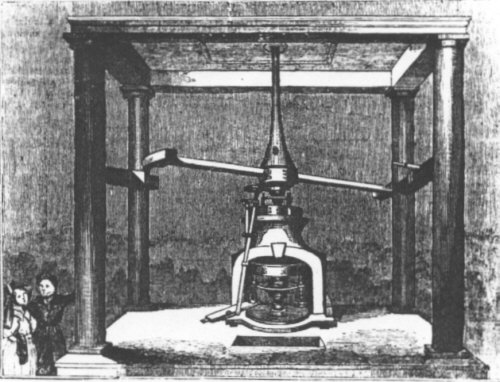| Matthew Boulton and James Watt |

Matthew Boulton's Soho Works in Birmingham, where condensing steam engines were first built and the first automatic coining presses were made. Problems at the Royal Mint in LondonIn the mid-1700s, the Royal Mint was failing in its task to supply the national requirements for bronze coinage and there was a shortage. Privately issued tokens were being widely used instead and workers were now being paid in them, even though their buying power was often half their face value. Something had to be done to ease the shortage, and Matthew Boulton was commissioned to make some new copper coinage for the Royal Mint. He established a reputation for making coinage of a consistent quality, and when problems arose with the manufacture of copper coinage in India, he was contracted to supply it, to be shipped out on the East India Company's ships Admiral Gardner and Britannia in 1809. Later, he was also to supply mint machinery to the Company's mints in Madras and Calcutta. Matthew Bolton Matthew Boulton was typical of the new men of the Industrial Revolution. He combined the shrewdness of the entrepreneur with the foresight of the visionary. In later life he became a Fellow of the Royal Society, and was known as one of the more benevolent industrialists, well known for his philanthropy (he established a theatre in Birmingham in 1807). He died on 17th August 1809, eight months after the ship bearing his coins in the Admiral Gardner came to grief on the Goodwin Sands. He started as a jeweller and brassware manufacturer, making buttons and other small brass goods in his Birmingham premises, the Soho Manufactory, which was established in Smethwick in 1761. James Watt In 1768 Boulton met James Watt, and because of his need for something to power his factory, he became interested in Watt's invention, the steam engine. Boulton first gained a share in the patent on Watt's steam engine as part payment for a debt from a fellow industrialist who went bankrupt. In 1775 Boulton and Watt became partners in the steam engine business, obtaining a 25-year extension of the patent. One of the first applications of the new invention was to power the pumps to drain the Cornish tin mines. Soho Works, Birmingham and the automatic coin press In 1786 Boulton applied steam power to his coining presses in the Soho works. Up until that time, coins had been produced by hand processes, which basically meant that blanks were placed into a press by workers who then had to screw down the machinery by hand to produce coinage. This was a laborious and time consuming process, made worse by the fact that the blanks were roughly cut out in the first place and often had to be hammered flat first to fit in the machine.
Boulton's coining press [This drawing originally appeared in The Saturday Magazine 23rd April 1836, and was later reproduced in the catalogue of the British Museum's exhibition 'Money', held in 1985.]
|
